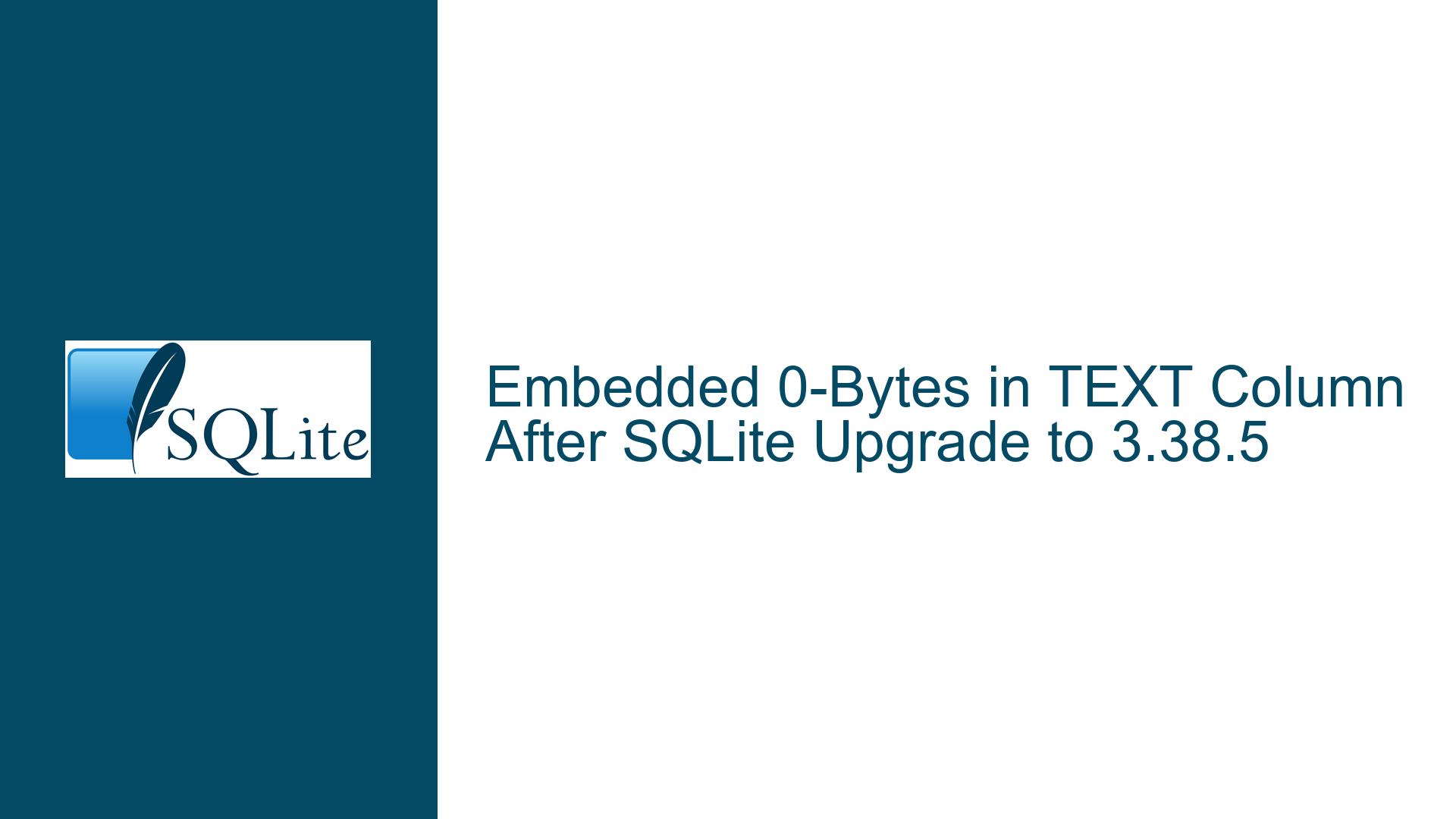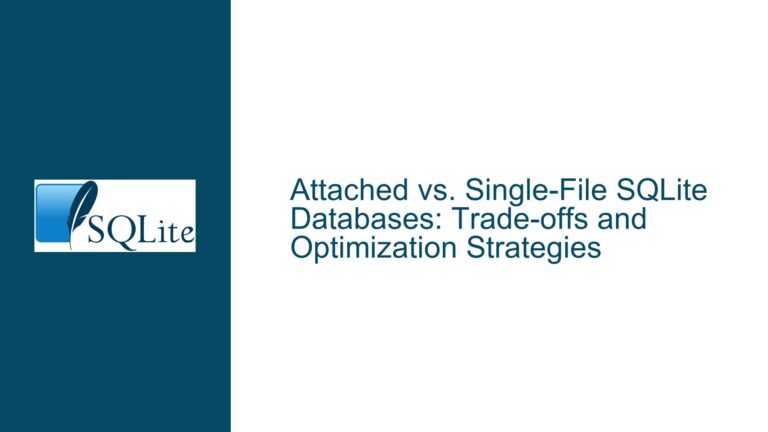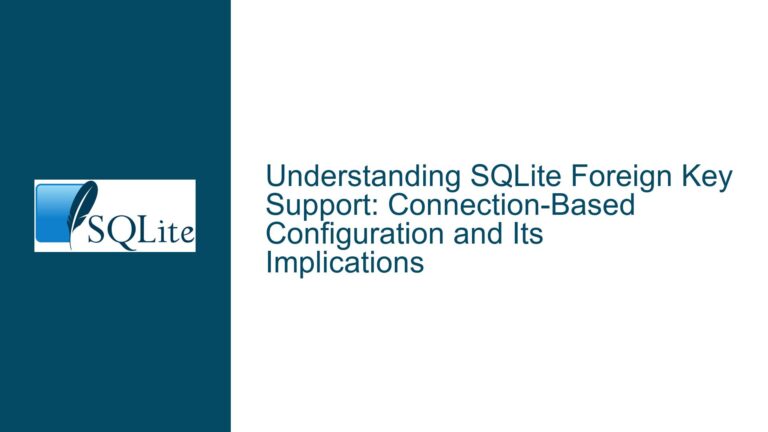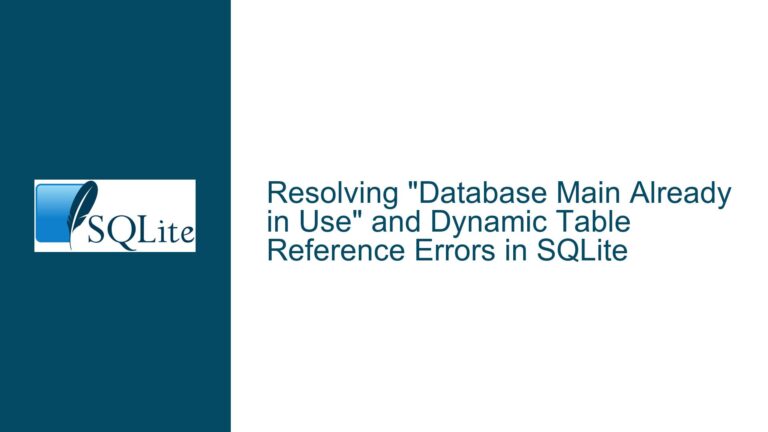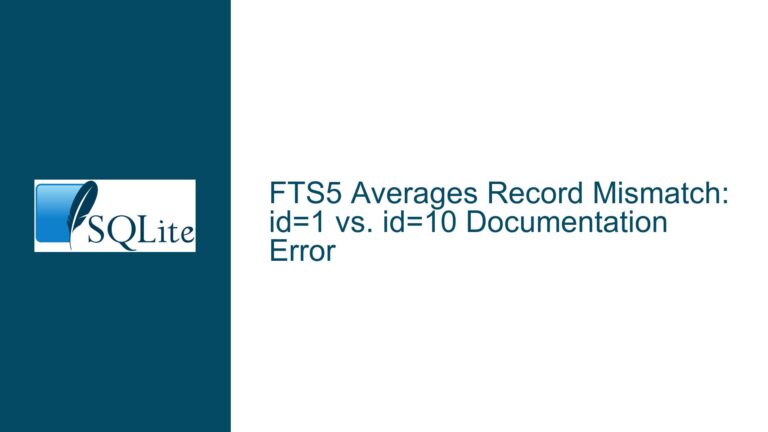Embedded 0-Bytes in TEXT Column After SQLite Upgrade to 3.38.5
Issue Overview: Embedded 0-Bytes in TEXT Column After SQLite Upgrade
The core issue revolves around the unexpected appearance of embedded 0-bytes in a TEXT column after upgrading from SQLite 3.31.1 to 3.38.5. The problem manifests when binding and writing standard Windows UNICODE text into the sname column of a table. The data, which previously stored clean text (e.g., "sys_writetest"), now contains embedded 0-bytes (e.g., "s<0>y<0>s<0>_<0>w<0>r<0>i<0>t<0>e<0>t<0>e<0>s<0>t<0>"). This behavior is observed only in older databases created prior to the upgrade, while newly created databases do not exhibit this issue.
The issue is tied to the internal encoding of the database. SQLite’s handling of text encoding has evolved, particularly around version 3.32.0, which introduced changes in how text data is stored and retrieved. The problem is exacerbated when the database’s internal encoding does not match the expected encoding (UTF-16LE in this case), leading to discrepancies in how text data is represented.
Possible Causes: Mismatched Database Encoding and API Behavior Changes
The root cause of the issue lies in the interplay between the database’s internal encoding and the behavior of the SQLite API when binding and retrieving text data. Here are the key factors contributing to the problem:
Database Encoding Mismatch: The database in question was created with an internal encoding of UTF-8, despite the application explicitly setting the encoding to UTF-16LE using
PRAGMA encoding='UTF-16le'. This mismatch causes the SQLite API to interpret and store text data differently than intended. When the database was created, the encoding pragma might not have been applied correctly, or the database might have been created with a default UTF-8 encoding before the pragma took effect.API Behavior Changes in SQLite 3.32.0: Starting with SQLite 3.32.0, the behavior of the
sqlite3_bind_text16function changed in how it handles text data when interacting with databases that have a mismatched encoding. In earlier versions (e.g., 3.31.1), SQLite might have silently converted text data to UTF-8 or handled the encoding mismatch more gracefully. However, in version 3.32.0 and later, SQLite strictly adheres to the specified encoding, resulting in embedded 0-bytes when storing UTF-16 text in a UTF-8 encoded database.Older vs. New Databases: The issue is specific to older databases because they were created with an unintended encoding (UTF-8). New databases, created with the correct UTF-16LE encoding, do not exhibit the problem. This discrepancy highlights the importance of ensuring consistent encoding settings during database creation.
Text Representation in Binary Form: When text data is stored in a UTF-8 encoded database but is bound using
sqlite3_bind_text16, the SQLite API stores the text in its raw UTF-16 form, including the 0-bytes that are inherent to UTF-16 encoding. This results in the observed behavior where the text appears to have embedded 0-bytes when viewed as binary data.
Troubleshooting Steps, Solutions & Fixes: Resolving Encoding Mismatches and Upgrading Safely
To address the issue of embedded 0-bytes in the TEXT column, follow these detailed troubleshooting steps and solutions:
1. Verify Database Encoding
The first step is to confirm the internal encoding of the database. Use the following SQL command to check the encoding:
PRAGMA encoding;
If the encoding is not UTF-16LE (e.g., it returns UTF-8), this confirms the encoding mismatch. This step is crucial for diagnosing the root cause of the issue.
2. Identify Affected Databases
Determine which databases were created with the incorrect encoding. This can be done programmatically by iterating through all databases and checking their encoding using the PRAGMA encoding command. Databases with UTF-8 encoding are likely to exhibit the issue when used with SQLite 3.32.0 or later.
3. Migrate Data to a New Database with Correct Encoding
For databases with incorrect encoding, the most reliable solution is to migrate the data to a new database with the correct UTF-16LE encoding. Follow these steps:
- Create a new database with the desired encoding:
PRAGMA encoding='UTF-16le'; - Export the data from the old database and import it into the new database. This can be done using the
.dumpand.readcommands in the SQLite CLI or programmatically using a script. - Verify that the data in the new database does not contain embedded 0-bytes when viewed as binary data.
4. Update Application Code to Ensure Consistent Encoding
To prevent future occurrences of this issue, update the application code to ensure that the database is always created with the correct encoding. This can be done by explicitly setting the encoding immediately after creating the database:
sqlite3_open_v2("database.db", &db, SQLITE_OPEN_READWRITE | SQLITE_OPEN_CREATE, NULL);
sqlite3_exec(db, "PRAGMA encoding='UTF-16le';", NULL, NULL, NULL);
Additionally, consider adding error handling to verify that the encoding pragma was applied successfully.
5. Handle Legacy Databases Gracefully
For applications that must work with legacy databases, implement a mechanism to detect and handle encoding mismatches. This can include:
- Checking the encoding of the database at startup.
- Providing a migration path for users to upgrade their databases to the correct encoding.
- Logging warnings or errors when an encoding mismatch is detected.
6. Test Thoroughly After Upgrading SQLite
When upgrading SQLite, thoroughly test the application with both new and legacy databases to ensure compatibility. Pay special attention to text handling and encoding-related behavior, as these are areas where changes in SQLite versions are most likely to cause issues.
7. Understand SQLite’s Text Handling Behavior
Familiarize yourself with SQLite’s text handling behavior, particularly how it translates between different encodings. Key points to understand include:
- The difference between the internal database encoding and the encoding used in API calls.
- How
sqlite3_bind_text16and similar functions interact with the database’s internal encoding. - The implications of accessing text data as binary data (e.g., using
sqlite3_column_blob).
8. Monitor SQLite Release Notes
Stay informed about changes in SQLite by regularly reviewing the release notes. This will help you anticipate and address potential issues when upgrading to newer versions.
By following these steps, you can resolve the issue of embedded 0-bytes in TEXT columns and ensure that your application handles text data correctly across different versions of SQLite.
